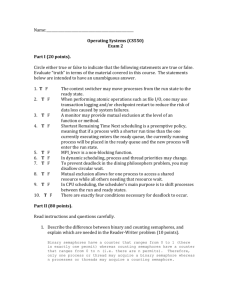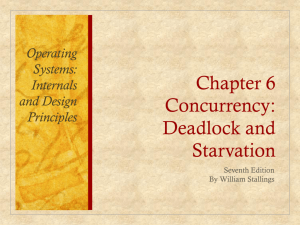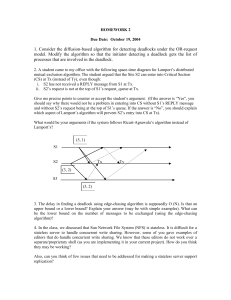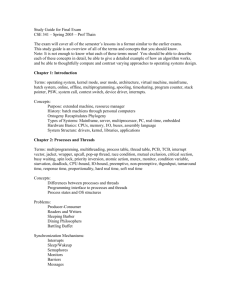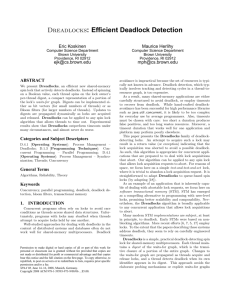Chapter 6 Concurrency: Deadlock and Starvation
advertisement
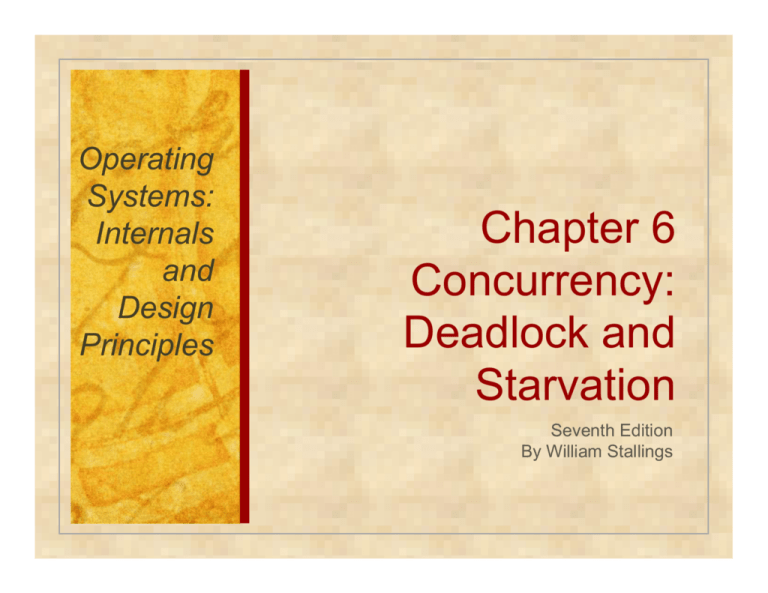
Operating Systems: Internals and Design Principles Chapter 6 Concurrency: Deadlock and Starvation Seventh Edition By William Stallings Operating Systems: Internals and Design Principles When two trains approach each other at a crossing, both shall come to a full stop and neither shall start up again until the other has gone. Statute passed by the Kansas State Legislature, early in the 20th century. —A TREASURY OF RAILROAD FOLKLORE, B. A. Botkin and Alvin F. Harlow The permanent blocking of a set of processes that either compete for system resources or communicate with each other A set of processes is deadlocked when each process in the set is blocked awaiting an event that can only be triggered by another blocked process in the set Permanent No efficient solution Potential Deadlock I need quad C and B I need quad D and A I need quad B and C I need quad A and B Actual Deadlock HALT until D is free HALT until A is free HALT until C is free HALT until B is free Joint Progress Diagram Reusable Resources Example Example 2: Memory Request Space is available for allocation of 200Kbytes, and the following sequence of events occur: P1 ... ... Request 80 Kbytes; Request 70 Kbytes; Request 60 Kbytes; Request 80 Kbytes; ... P2 ... Deadlock occurs if both processes progress to their second request Consider a pair of processes, in which each process attempts to receive a message from the other process and then send a message to the other process: Deadlock occurs if the Receive is blocking Deadlock Detection, Prevention, and Avoidance Resource Allocation Graphs Resource Allocation Graphs Conditions for Deadlock Dealing with Deadlock Three general approaches exist for dealing with deadlock: Design a system in such a way that the possibility of deadlock is excluded Two main methods: Indirect prevent the occurrence of one of the three necessary conditions Direct prevent the occurrence of a circular wait No Preemption if a process holding certain resources is denied a further request, that process must release its original resources and request them again OS may preempt the second process and require it to release its resources Circular Wait define a linear ordering of resource types A decision is made dynamically whether the current resource allocation request will, if granted, potentially lead to a deadlock Requires knowledge of future process requests Referred to as the banker’s algorithm State of the system reflects the current allocation of resources to processes Safe state is one in which there is at least one sequence of resource allocations to processes that does not result in a deadlock Unsafe state is a state that is not safe State of a system consisting of four processes and three resources Allocations have been made to the four processes Amount of existing resources Resources available after allocation P3 Runs to Completion Thus, the state defined originally is a safe state Deadlock Avoidance Logic It is not necessary to preempt and rollback processes, as in deadlock detection It is less restrictive than deadlock prevention Maximum resource requirement for each process must be stated in advance Processes under consideration must be independent and with no synchronization requirements There must be a fixed number of resources to allocate No process may exit while holding resources Deadlock Strategies Deadline Detection Algorithms A check for deadlock can be made as frequently as each resource request or, less frequently, depending on how likely it is for a deadlock to occur Advantages: it leads to early detection the algorithm is relatively simple Disadvantage frequent checks consume considerable processor time Recovery Strategies Abort all deadlocked processes Back up each deadlocked process to some previously defined checkpoint and restart all processes Successively abort deadlocked processes until deadlock no longer exists Successively preempt resources until deadlock no longer exists Dining Philosophers Problem •No two philosophers can use the same fork at the same time (mutual exclusion) •No philosopher must starve to death (avoid deadlock and starvation) Cont. A Second Solution . . . Solution Using A Monitor UNIX Concurrency Mechanisms UNIX provides a variety of mechanisms for interprocessor communication and synchronization including: Pipes Circular buffers allowing two processes to communicate on the producer-consumer model first-in-first-out queue, written by one process and read by another Messages A block of bytes with an accompanying type UNIX provides msgsnd and msgrcv system calls for processes to engage in message passing Associated with each process is a message queue, which functions like a mailbox Shared Memory Fastest form of interprocess communication Common block of virtual memory shared by multiple processes Permission is read-only or read-write for a process Mutual exclusion constraints are not part of the shared-memory facility but must be provided by the processes using the shared memory Generalization of the semWait and semSignal primitives no other process may access the semaphore until all operations have completed A software mechanism that informs a process of the occurrence of asynchronous events similar to a hardware interrupt, but does not employ priorities A signal is delivered by updating a field in the process table for the process to which the signal is being sent A process may respond to a signal by: performing some default action executing a signal-handler function ignoring the signal UNIX Signal s Linux Kernel Concurrency Mechanism Includes all the mechanisms found in UNIX plus: Atomic Operations Atomic operations execute without interruption and without interference Simplest of the approaches to kernel synchronization Two types: Linux Atomic Operation s Spinlocks Most common technique for protecting a critical section in Linux Can only be acquired by one thread at a time any other thread will keep trying (spinning) until it can acquire the lock Built on an integer location in memory that is checked by each thread before it enters its critical section Effective in situations where the wait time for acquiring a lock is expected to be very short Disadvantage: locked-out threads continue to execute in a busy-waiting mode Semaphore s User level: Linux provides a semaphore interface corresponding to that in UNIX SVR4 Internally: implemented as functions within the kernel and are more efficient than user-visable semaphores Three types of kernel semaphores: binary semaphores counting semaphores reader-writer semaphores Linux Semaphor es Barriers enforce the order in which instructions are executed Table 6.6 Linux Memory Barrier Operations Synchronization Primitives Solaris Data Structure s Used to ensure only one thread at a time can access the resource protected by the mutex The thread that locks the mutex must be the one that unlocks it A thread attempts to acquire a mutex lock by executing the mutex_enter primitive Default blocking policy is a spinlock An interrupt-based blocking mechanism is optional Semaphores Readers/Writer Locks Allows multiple threads to have simultaneous read-only access to an object protected by the lock Allows a single thread to access the object for writing at one time, while excluding all readers when lock is acquired for writing it takes on the status of write lock if one or more readers have acquired the lock its status is read lock Windows 7 Concurrency Mechanisms Windows provides synchronization among threads as part of the object architecture Table 6.7 Windows Synchronization Objects Similar mechanism to mutex except that critical sections can be used only by the threads of a single process If the system is a multiprocessor, the code will attempt to acquire a spin-lock as a last resort, if the spinlock cannot be acquired, a dispatcher object is used to block the thread so that the kernel can dispatch another thread onto the processor Slim Read-Writer Locks Windows Vista added a user mode reader-writer The reader-writer lock enters the kernel to block only after attempting to use a spin-lock It is slim in the sense that it normally only requires allocation of a single pointer-sized piece of memory Windows also has condition variables The process must declare and initialize a CONDITION_VARIABLE Used with either critical sections or SRW locks Used as follows: 1. acquire exclusive lock 2. while (predicate()==FALSE)SleepConditionVariable() 3. perform the protected operation 4. release the lock Lock-free Synchronization Windows also relies heavily on interlocked operations for synchronization interlocked operations use hardware facilities to guarantee that memory locations can be read, modified, and written in a single atomic operation Deadlock: the blocking of a set of processes that either compete for system resources or communicate with each other blockage is permanent unless OS takes action may involve reusable or consumable resources Consumable = destroyed when acquired by a process Reusable = not depleted/destroyed by use Dealing with deadlock: prevention – guarantees that deadlock will not occur detection – OS checks for deadlock and takes action avoidance – analyzes each new resource request



